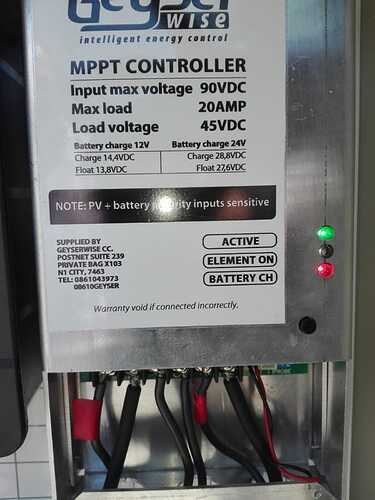I’ll do that ![]()
Edit: I had a look but thread is entwined… I’ve renamed the thread for better description.
I can’t see how they are different:
The exact same PV panels and wiring
The sun at noon on a clear day
And we see how much power is being fed into the geyser elements respectively.
Each system has its own optimiser for maximum power transfer to its own heater element.
The Geyserwise dual element is a PTC device. I don’t know the reason but guessed that the safety aspect of preventing overheating of the geyser. (resistance increases above 75 deg C)
The challenge still stands!
It sounds to me a little pointless. It takes 1.16Wh of energy to heat one liter of water by 1°C. Regardless of how you do it.
The differences will be in how efficient you track the MPP of the panels, and the losses inside the converter. Which both solutions have.
Being able to use a standard element makes the boost converter option the winner in my opinion.
Those prices are getting close to a heatpump. That would be my choice then I can share the PV panels with the rest of the home and have hot water in the mornings as well ![]()
This ITS 3.6kW model is going for R15k
https://itssolar.co.za/product/3-6kw-its-residential-heat-pump/
Remember to keep in mind the extra material and labour. I have that same one, and if I recall the extra material alone was easily another 5k.
One thing that takes a big bite out of the budget is copper piping. Those are R600 for a 5 meter length now. And the lagging isn’t cheap either, at close to R100/meter these days.
But once it is in… man what a pleasure.
The Geyserwise doesn’t have a converter:
But you said it has MPP tracking? If it has MPP tracking… it has a “converter”, possibly of the buck variety.
For that reason I expect them to break even.
If you’re right and there is no impedance matching going on… I expect the geyserwise to lose badly.
Yes it does but there’s no boost or buck noticeable. (Definitely not a charge controller)
The voltage is reduced slightly from the PV input (80V approx) but my understanding is this is to match impedance…
So the DC element runs at around 80V?
The PTC element increases dramatically in resistance as the temperature goes up. Random picture snapped of a website…

Y Axis is exponential.
Assuming the panels run at their maximum power point all of the time, they two solutions should have the same performance up to maybe 60°C. After that I think the one using the traditional element is going to win.
This whole line of thought makes me wonder how people can sell those PTC elements and tell you “they are more efficient”. They simply are not… they make the same water with the same energy and towards the end they slow down significantly, making it hard to store “extra heat” in the tank and mix it down with a tempering valve.
Agreed. Remember this is a dual element with a 220V and a 90V element in one housing.
Is this available in a regular resistive element?
Perhaps because people stopped buying their fuel savers, so they had to move on. Con artists have to eat too ![]()
Correct!
The drop in current is rapid at 75°C
So it keeps heating right up to that temperature (as one is getting nervous expecting steam to start blowing off somewhere… ![]() )
)
